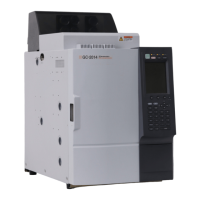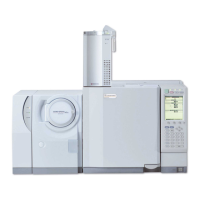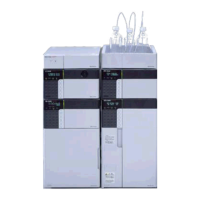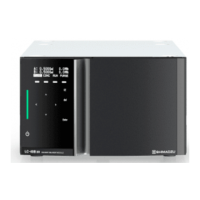13 Detector
13.2 Thermal Conductivity Detector (TCD)
167
GC-2014
FILTER TIME CONSTANT
Selection: 4 ms/5 ms/10 ms/20 ms/50 ms/100 ms/200 ms/500 ms/1 s/2 s, Default: 1 s
This constant affects the processing of the detector signal.
As the time constant increases, noise as well as the peak height are reduced.
Select the optimum value in accordance with the peak half width. (Refer to “13.3 Filter
Signal Time Constant”.)
SIGNAL OUTPUT PORT
Selection: Off/Ch1/Ch2/Ch3/Ch4, Default: (Channel is automatically assigned.)
Select the digital and analog signals output Channels. Four channels are available.
However, for analog output, only Ch1 and Ch2 are available as standard.
BACKGROUND SIG. SAVE
Selection: Off/Buff 1/Buff 2, Default: Off
Background baseline signals can be saved for the purpose of background subtraction.
BACKGROUND SIG COMP.
Selection: Off /Buff 1/Buff 2, Default: Off
Subtracts the saved background signal baseline from the actual baseline. This pro-
duces a stable baseline despite considerable baseline fluctuations.
DET SIG SUBTRACTION
Selection: Off /DET#1/DET#2/DET#3/DET#4, Default: Off
Subtracts the detector signal of one detector from the signal of another detector.
For the details on background save and background compensation, refer to “13.4
Background Compensation”.
SIGNAL RANGE
Selection: ×1/×10
-1
/×10
-2
/×10
-3
/×10
-4
/, Default: ×10
-1
Multiplies the analog signal by the coefficient “10
-x
” for a linear analog signal type. If the
data processing unit is saturated, for example, change the setting from “×1” to “×10
-1
”,
from “×10
-2
” to “×10
-3
”. In case of the digital signal, the signal is always output with “×1”.
SIGNAL ATTENUATION
Selection: ×1/×2
-1
/×2
-2
/×2
-3
/×2
-4
/, Default: ×2
-1
Multiplies the analog signal by the coefficient “2
-x
” for a wide analog signal type. If the
data processing unit is saturated, for example, change the setting from “×1” to “×2
-1
”,
from “×2
-2
” to “×2
-3
”. In case of the digital signal, the signal is always output with “×1”.
ANALOG SIGNAL TYPE
Selection: Linear/Wide, Default: Linear
Set this item when the GC is connected to a Chromatopac in analog format.
Wide ... Select Wide when connecting the GC to the C-R8A/C-R7A/C-R7A plus.
The GC outputs square root of the original signals to the Chromatopac, and the
received signals are squared in the Chromatopac.
When connecting the GC to a C-R7A/CR-7A plus for the first time, or replacing
the Chromatopac, set the detector signal output to “Off” and perform
calibration. (For the calibration procedure, refer to “2.2 Outputting Analog
Signals to the Chromatopac”.)
Linear...Select linear when connecting the GC to any Chromatopac other than the C-
R7A/CR-7A plus.
When connecting the GC to the C-R8A/C-R7A/C-R7A plus and setting the
“ANALOG SIGNAL TYPE” to “Linear,” the optional signal cable (linear, P/N
221-47251-92) is required.
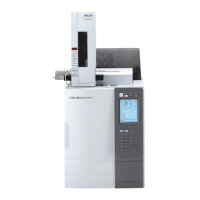
